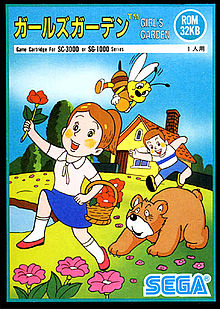Development
Girl's Garden was the first game developed for Sega by programmers Yuji Naka and Hiroshi Kawaguchi. [6] [7] After Naka joined Sega in April 1984, he was asked by his supervisor to try developing games for girls as part of his initial month of training. [6] Naka collaborated with Kawaguchi, another new programmer at Sega, [8] and showed their progress on Girl's Garden to their supervisor after about two months. [6] Their boss decided it was good enough to be worked into a full game and sold for the SG-1000. [6]
Development on Girl's Garden lasted five months. [6] Hardware limitations made scrolling the screen and displaying many sprites difficult. Since the system could only render four sprites per scanline, Naka and Kawaguchi instead drew the enemy bears in the background. It was difficult to scroll the background layer while also moving the bears around the screen and animating the blooming flowers. [6] The music and sounds were programmed by Tohru Nakabayashi and Katsuhiro Hayashi. [6] [8]
It took three months to manufacture the ROM chips. Sega produced around 80,000 copies of Girl's Garden, half of which were sold. [6] According to contemporary game publication Game Machine, the game was released in January 1985. [1] In 1998, Sega Saturn Magazine (Japan) wrote that it was released in December 1984. [9] In a 2002 interview, Naka argued that the game's development and manufacturing time meant it could not have possibly been released in 1984. He believed the game was released in February 1985, and recalled his supervisors warning him that games do not sell well in February. [6]
This page is based on this
Wikipedia article Text is available under the
CC BY-SA 4.0 license; additional terms may apply.
Images, videos and audio are available under their respective licenses.

